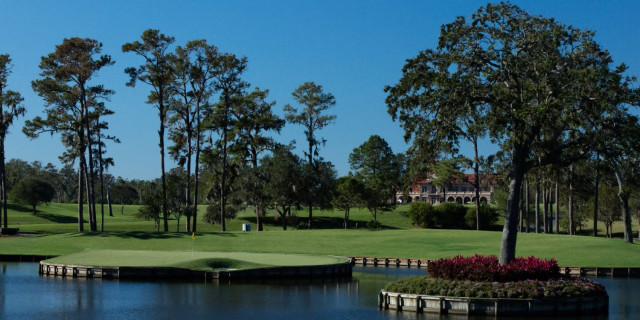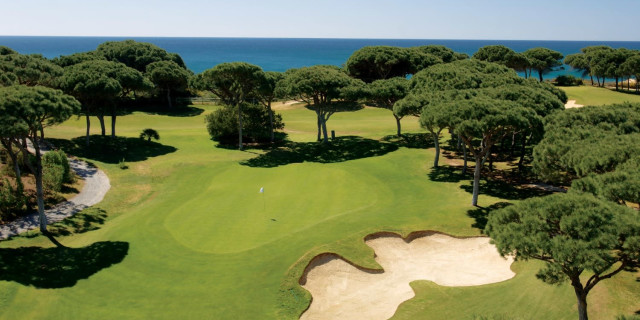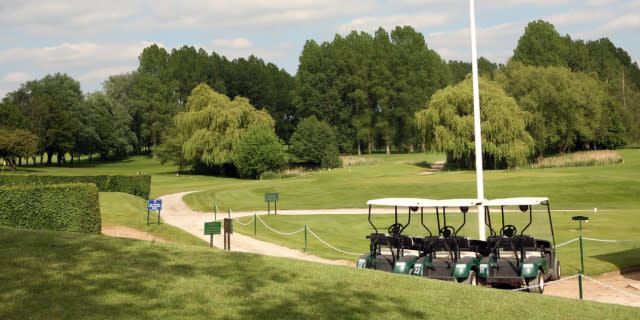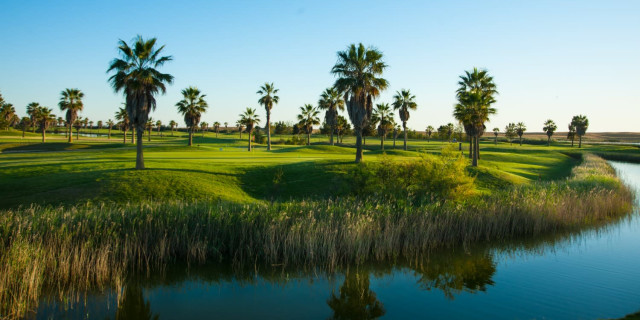Bedlingtonshire Golf Club Review
Bedlingtonshire Golf Club is situated in Northumberland just 20 minutes outside of Newcastle and easily accessible from the A1. If you have not visited Northumberland, it is home to some of the best coastline in England and historic castles like Bamburgh, Dunstanburgh and of course Alnwick (just ask any Harry Potter fan). It is a wonderful part of the country and worthy of a golf trip. It’s four hours drive from South Birmingham (where I live), so a similar length trip to Cornwall.
Bedlington and the surrounding area has a wonderful history of coal mining and Bedlingtonshire Golf Club was actually built on the site of an opencast coal mine (not that there is any visible evidence). But this history lives on with many of the golf holes bearing names reminiscent of its coal mining heritage.
The course, which opened in 1972, is among an array of world-renowned golf courses crafted by the Dutch-born architect Frank Pennink, whose other work includes The Old Course at Vilamoura, Portugal, (where the 6th hole is modelled on Bedlingtonshire’s 9th!), as well as other local courses at Goswick and Seaton Carew. Pennink was also instrumental in the modifications to none other than Royal St George’s, Royal Lytham & St Annes, and Royal Liverpool (Hoylake) where The Open has just been held.
Bedlingtonshire Golf Club is just a few minutes off the A1 on the edge of the small town of Bedlington, which boasts a number of pubs and restaurants. Just two minutes from the course is Lairds House - a brand new hotel that opened in 2020 (despite the pandemic) and has double rooms ideally suiting golfing partners wanting to stay locally.
The golf club is set among charming agricultural land providing some beautiful views. It has 750 members and warmly welcomes visitors (in 13 years it has never received a bad review from a visitor!). It has hosted county championships, county senior’s events and the Wansbeck Classic Pro-Am.

Pre-Round Thoughts
Approaching the clubhouse you walk from the car park through an interesting hedge lined path, which initially seems a little basic and dated but then you walk out to see the immaculate 18th green and 1st tee. The 80-seater lounge has huge windows overlooking the course (and a members’ lounge at the back for 20 people when the lounge is occupied). The catering is phenomenal. I had the best bacon sandwich I can recall anywhere. A variety of flavours of sausage rolls and pasties are cooked on site (£1.65 for homemade sausage rolls and £2.30 for pastries). All charmingly served by Karla behind the bar.
I was met by the Club Manager Mark Sanderson who, like the Course Director David Wailes, has been with the club for decades and provided a tour of the clubhouse which shows its 50 years of continual development (and some wonderful photos of the old mine and some of the huge machinery deployed - like the excavator ‘Big George’ - which is preserved eternally as the name of the 17th hole).
I typically enquire about the signature hole where Mark explained it is a series of three holes (13-15) that they call ‘The Park’ at the farthest part of the course (on land just outside of the quarry boundary). Their own ‘Amen Corner’ is beguiling, full of pink and purple blooming rhododendrons in May/June, but it is tight and can easily be a card wrecker if concentration lapses (as I later found out for myself).
Bedlingtonshire has a par of 73 (due to having five par 5s) and due its 6,630 yard length off the yellow tees (6,813 off whites) no doubt contributes to its course rating of 138, which is a lot higher than most you will visit. So don’t expect a walk in the park! But at £35 for a round it provides a great value day’s golf.
Although I did not use them, the club has a 220 yard driving range, a lovely 9-hole putting green encircling a flower bed and a chipping area - practice facilities many a club would envy.
Front 9 Overview
The first thing I noticed was how nice the tees are with lush green grass and perfectly manicured and framed. Even the rubbish bins on the course boast the club’s emblem. There are numerous three-seater garden seats too - all nice touches throughout the course. Another nice feature is the huge variety of different trees, making for a very interesting spectacle and even the occasional gorse bush to keep you honest! Never once would you conclude this course has only just celebrated 50 years - it feels much more established.
The first is a par 5 slightly dog-legging to the right with bunkers at 200 on the corner and hidden from the tee by trees is a pond at around 220 yards on the right-hand side. Two greenside bunkers guard the green for this nice opening hole measuring 475 yards. It is immediate that I notice the excellent quality of the greens, even after the hugely wet July we have had - they were in superb, unblemished condition and a joy to putt on.
The second is another nice par 5 which is rather more downhill and bends to the right. There are two fairway bunkers either side of the fairway to thread your tee shot between (on the right at 180 yards and 220 on the left). Like the first, the second green is framed nicely by trees, providing a lovely backdrop to a green that is in fantastic condition.
I notice that although only minutes from the A1, the golf course is incredibly quiet, only a faint distant sound of the A1 on occasions, but mostly the silence is broken by the sound of birds - seagulls (reminding you how close to the sea you are), and birds of prey like kites and buzzards. It really is an idyllic part of the country.
The third. Rare that you are faced so early in a round by a par 4 SI 1 measuring 450 yards off yellows. Here I notice another nice feature that all the steps to the tees have astroturf inserted to the steps providing non-slip access in all conditions.
It has one large fairway bunker on the right-hand side of the fairway awaiting any drive that leaks to the right at 215 yards. This hazard is accentuated by a fairway that slopes left to right. Your second shot is then over a crest in the fairway (which I soon realise is a common feature of this anything but flat course) so you need to aim for a marker post, adding additional interest to this hole.
Again, this is another nicely framed hole with trees surrounding which provides a picturesque approach to a green guarded once more by two bunkers short left and right.
The fourth dog-legs left again played off a tee with astroturfed steps. This is the blind testing tee shot and the hole is called ‘Miner’s Bell’ so listen out for the bell before you play. It is not a long hole though SI 5 at 375 yards. A bunker awaits short right and there’s a run-off long and left.
The fifth is a mid-length par 4 at 365 yards with another blind fairway where you play to the crest of a hill. There are trees pinching in from the right-hand side, narrowing your focus on this tee shot. As you reach the top of the crest of the fairway, you start to see all the farmland around showing what a peaceful location this golf course is set amongst. Then there is around a 140 yard drop down to a picturesque green guarded by bunkers left and right. It is a wonderful view seeing the farmer’s fields between the green and the blue sky yonder. Just beautiful.
Walking across the ninth hole you climb up to the sixth which is par 3 of 178 yards all downhill with bunkers waiting left and right - this hole is called ‘Ironworks’ (a nod of appreciation to Bedlington’s history from which George Stephenson took his rails, which were fundamental in the Industrial Revolution!).
The seventh is the third and hardest of the par 5s at 497 yards downhill initially before climbing up to the green. This hole sweeps beautifully from right to left but beware the bunker on the right-hand side of the fairway at 190 yards. It then plays uphill to an elevated green close to the first tee and clubhouse. Three bunkers await. It was here I experienced my first bunker of the day, and even though there had been lots of rain, and the course was damp in places, you could tell the quality of the sand, even in a moist bunker. I later heard there will be more work done to the bunkers in the coming months, though I thought the quality of sand was excellent.
So far there have been dog-legs left and right downhill, now the eighth dog-legs uphill to the right showing there is huge variety on this course. Beware the smallest gorse bush at 200 yards on the left-hand side waiting to gobble up any overdrawn drive. Then it’s uphill all the way to a green with two bunkers waiting left and right to catch any under-hit approach. This green is also nicely framed by trees at the back.
Beware the hole has a run-off on the left long, and to the right to swallow any shots missing the green - not an easy hole in the slightest.
This is where you could eat your halfway house treat at the highest point on the course (incredibly well priced sausage and bacon sandwiches for £4) which can be ordered as you play the 6th tee and collected on the 8th tee.
Overall, the first eight holes were nice, and not overly difficult. But then the real test commences on the ninth. It is one of the toughest downhill pars 3s you’ll face at 220 yards. The aforementioned designer used this hole to model the 6th at The Old Course at Villamoura. It is a beautiful hole with the farmer’s fields framing the hole like on the fifth – but a tough one just due to the length and the intimidation factor. A par here is a net birdie for most with an SI of 3.

Back 9 Overview
The tenth is straightforward par 4 which bends a little left at 371 yards. Again, a slightly blind tee shot and you can just make out the bunkers halfway down at around 220 yards left and right of the fairway. Missing those provides a simple shot in.
One of the easiest par 5s if played in regulation. The eleventh features another blind tee shot downhill to a wide open fairway providing plenty of room. If you choose to lay-up short of the two cross bunkers it leaves a simple wedge in - just note the two bunkers lurking left of the green. SI 16 and one of the easiest par 5s which then gets you ready for the next challenge.
“Auld Pit” (Old Pit) is up next (named because the colliery had a shaft known as the ‘Auld Pit’) a par 4 at just 347 yards, so not a long hole. There are two raised bunkers visible right on the corner of the dog-leg, which is all you can see of the fairway. Just beware the ditch that runs the whole left side of the fairway. It’s an attractive hole. When you get to the green, you’ll see it’s again wonderfully framed by trees. (This is such a nice golf course). The green has some interesting tiers and undulations to provide an interesting test with a flat stick to avoid a three-putt.
The thirteenth is a par 4 bending to the left and the beginning of ‘The Park’ threesome. Your tee shot needs to avoid the coppice of horsechestnut tress at 200 yards on the right-hand side (hence the hole’s name ‘Conkers’), and then it’s a downhill approach into a green. There are bunkers to the left and two to right of the green and running down the left-hand side of the fairway there are more horsechestnut trees all the way making quite an intimidating approach shot.

The next hole appears to be a straight-forward par 3 at 154 yards, which is the farthest point of the course and plays alongside the grounds to some nice houses and gardens. But keep your concentration as there are three bunkers to test your aim and there is a steep run-off long right and water awaits here. Rhododendrons lie long left so a precise shot is required. I found out why the secretary calls this Amen Corner to my own peril on this SI 18 hole.
The fifteenth is also very picturesque and possibly the hardest tee shot needing to be thread in a narrow chute between two large trees - which have crushed many a member’s hopes of a good score! The green sits below the level of the fairway but don’t be too long as there is a drop off long and right.
For sure this is a lush, green corner of the course providing great fun. You can see why the management have had to put signs saying: ‘please do not repeat this loop during your round.’ I was very, very tempted especially after dropping two points round The Park.’ Now knowing the course, I realise I could do much better. I’ll just have to wait for a return visit.
The sixteenth starts the homeward stretch and offers a wide open fairway which doglegs left suiting a good hard draw (usually into the wind) at 430 yards. You can see why this par 4 is SI 2 especially when the wind is up. The green is guarded by two bunkers left and right and run-offs long gathering any over-zealous approaches to this quite generous green.
The penultimate hole is another stern par 3 tester. All 180 yards are up-hill making this the second of two brutish par 3s on this course. There’s one bunker right and two left giving you little margin for error.
Finally, the eighteenth is mid length (511 yard) par 5. The fifth par 5 of the round which sweeps to the left around a line of trees on the boundary of the course. The pond on the first hole also comes into play on the right-hand side and your approach shot needs to avoid two bunkers left and right of a deep green right in front of not only the clubhouse, but a huge scoreboard which is a really nice finishing touch to a fine round.

Post-Round Thoughts
Considering the amount of rain that fell the day before, there was very little surface water on the course, showing what a great drainage system there is.
Before heading home, I met the Course Director David Wailes (who played just behind me). Although the course was in tip top condition, he explained his plans for continual refinement of the course (including irrigation and more bunker work). His longevity of 33 years as a member here and not resting on any laurels really spoke volumes to me about the course and its management.
Interestingly, my electric golf trolley has a slight fault, whereby if I hit a bump or a stone on the path it disconnects. Very frustrating. This means I can lose power a dozen times at my home club. But incredibly this never happened once throughout the whole round at Bedlingtonshire - it did not hit a single bump. Just another indication of the high quality of this course, and its paths.
On another personal note my handicap has been steadily climbing over this summer, however I found playing at Bedlingtonshire was a very peaceful experience and with the resulting very calm head I played some of my best golf this year.
Verdict
Charming parkland course with a great variety of holes each with top quality tees and greens. It would fit nicely into a trip alongside its ‘links style’ neighbours like Whitley Bay, Bamburgh, Dunstanburgh and Goswick. Bedlingtonshire Golf Club should definitely be on your golf trip to the North East coast.
Overall Rating - 9
Course (Conditions) - 10
Course (Hole Variety/Layout) - 10
Course (Green Condition) - 10
Course (Challenge/Difficulty) - 8
Club Facilities & Clubhouse - 9
Practice Facilities - 10
Friendliness/Hospitality - 10
Pace of Play - 10
Value For Money - 10
Related Content: travel review golfshake Golf Courses England Courses

















